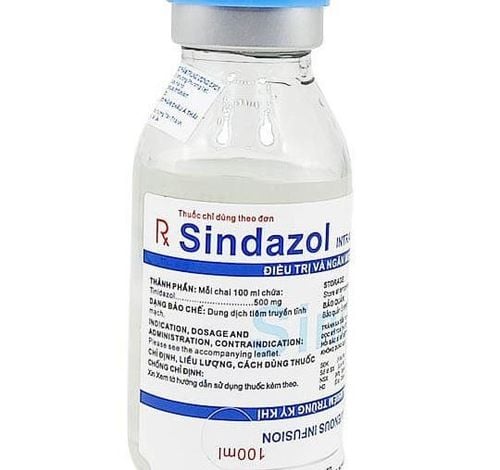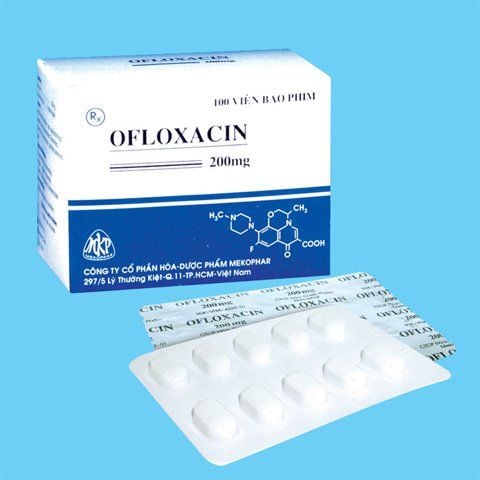This is an automatically translated article.
Pipranir TZ contains the active ingredients Piperacillin and Tazobactam. Pipranir TZ is indicated for the treatment of moderate to severe infections caused by beta-lactamase-producing bacteria resistant to Piperacillin but sensitive to Piperacillin in combination with Tazobactam.1. What is Pipranir TZ?
Pipranir TZ has the main active ingredient: Tazobactam sodium equivalent to Tazobactam 0.5g and Piperacillin sodium equivalent to Piperacillin 4g. Pipranir TZ is available as a white to pale yellow sterile powder for injection.Piperacillin sodium is a semi-synthetic antibiotic, derivative of aminobenzylpenicillin. Tazobactam sodium, beta-lactamase inhibitor is a penicillanic acid sulfone, derivative of the penicillin nucleus.
The bactericidal effect of Piperacillin is inhibition of septum formation and cell wall synthesis. Tazobactam is a beta-lactamase inhibitor of Piperacilinase and cephalosporinase richmond sykes type III. Tazobactam is not a chromosomal beta-lactamase-mediated inducer with concentrations of tazobactam achieved with recommended administration.
In Vitro, Piperacillin is active against gram-positive and gram-negative aerobic and anaerobic bacteria. In vitro, Tazobactam exhibits partial clinical activity against bacteria by reducing the affinity of penicillin-binding proteins. However, there is a beta-lactamase inhibitor of penicillinase and the Richmond-Sykes cephalosporinase type III. It alters the ability to inhibit type II and IV penicillinases. Tazobactam is not a chromosomal beta-lactamase-mediated inducer with concentrations of tazobactam achieved at recommended doses.
Facultative aerobic gram-positive microorganisms: Staphylococcus aureus (except methicillin and oxacillin resistant isolates). Facultative aerobic gram-negative microorganisms: Acinetobacter baumannii, Escherichia coli, Haemophilus influenzae (except for ampicillin-resistant strains that do not secrete beta-lactamases), Klebsiella pneumoniae, Pseudomonas aeruginosa (when the drug is used in combination with an aminoglycoside antibiotic that does not produce beta-lactamases). susceptible isolates). Anaerobic Gram-negative bacteria: Bacteroides fragilis (B. fragilis, B. ovatus, B. thetdiotdomicron, and B. vulgatus). In vitro, at least 90% of the following microorganisms had minimum inhibitory concentrations less than or equal to the sensitivity of piperacillin/tazobactam. However, the safety and efficacy of piperacillin/tazobactam in the treatment of clinical infections caused by these organisms have not been established in adequate and well-controlled clinical trials.
Facultative aerobic gram-positive bacteria: Enterococcus faecalis (only isolates susceptible to Ampicillin or Penicillin), Staphylococcus epidermidis from methicillin and oxacillin resistant isolates, Streptococcus agalactiae, Streptococcus pneumoniae (isolated strains). susceptible to penicillin), Streptococcus pyogenes, Streptococci group Viridans. Facultative aerobic gram-negative bacteria: Citrobacter koseri, Moraxella catarrhalis, Morganella morganii, Neisseria gonorrhoeae, Proteus mirabilis, Proteus vulgaris, Serratia marcescens, Providencia stuartit, Providencia rettgeri, Salmonella enterica. Anaerobic Gram-positive bacteria: Clostridium perfringens. Anaerobic gram-negative bacteria: Bacteroides distasonis, Prevotella melaninogenica.
2. Indications and contraindications to Pipranir TZ
2.1. Point
Pipranir TZ is indicated for the treatment of moderate to severe infections caused by beta-lactamase producing bacteria resistant to Piperacillin but sensitive to Piperacillin in combination with Tazobactam in the following infections:Lower respiratory tract infections: . Urinary tract infection. Pelvic inflammatory disease. Appendicitis. Uncomplicated skin infections including cellulitis, subcutaneous abscesses, and diabetic foot infections. Peritonitis . Community-acquired pneumonia (moderate only). Hospital-acquired pneumonia (moderate to severe). Bacterial cultures and antibiograms are performed prior to initiation of antibiotic therapy to isolate and determine the causative organism and susceptibility to Piperacillin and Tazobactam. Antibiotic therapy should be adjusted accordingly, when results of bacterial cultures and antibiograms are available.
2.2. Contraindications
Use Pipranir TZ in patients who are allergic or hypersensitive to penicillins, cephalosporins or beta-lactamase inhibitors.3. How to take Pipranir TZ
3.1. How to use
Pipranir TZ is administered by intravenous infusion over 30 minutes.The usual dose of Pipranir TZ for adults is an intravenous infusion of 1 4.5g vial (including Piperacillin 4g and Tazobactam 0.5g) every 8 hours for a total dose of 13.5g. A smaller dose of 3.375g every 6 hours for a total dose of 13.5g has also been used.
Initial treatment for patients with hospital-acquired pneumonia should start at 4.5g every 6 hours, in combination with an Aminglycoside, for a total dose of 18g. Treatment with aminoglycosides should be continued in patients with Pseudomonas aeruginosa in culture results.
In patients with renal impairment, the dose of Pipranir TZ is adjusted below:
| Độ thanh thải Creatinin | Liều khuyến cáo | Viêm phổi mắc phải ở bệnh viện |
| >40 - 90ml/ phút | 3.375g mỗi 6 giờ | 4.5g mỗi 6 giờ |
| 20 – 40ml/ phút | 2.25g mỗi 6 giờ | 3.375g mỗi 6 giờ |
| <20ml/ phút | 2.25g mỗi 8 giờ | 2.25g mỗi 6 giờ |
3.2. Instructions for reconstituting the solution for intravenous injection
Reconstitute Pipranir TZ, per gram of Piperacillin with 5 ml of compatible diluents from the solutions below. 4.5g Pipranir TZ was reconstituted with 20 ml of solution until dissolved. The solution should be used immediately after reconstitution. Discard unused portion after 24 hours if stored at room temperature (20 degrees C to 25 degrees C), or after 48 hours if stored at refrigerator temperature (2 degrees C to 8 degrees C).3.3. Compatible diluent
Compatible diluents: NaCl 0.9%, sterile water for injection, 5% Dextrose. Pipranir TZ reconstituted solution should be further diluted (recommended volumes per dose 50 ml to 150 ml) in a compatible intravenous diluent listed below. Infusion over a period of at least 30 minutes.3.3. Compatible solutions for intravenous dilution
NaCl 0.9%, sterile water for injection, Dextrose 5%, Dextran 6% in physiological saline. aCl 0.9%, sterile water for injection, dextrose 5%, dextran 6% in physiological saline. aCl 0.9%, sterile water for injection, dextrose 5%, dextran 6% in physiological saline. aCl 0.9%, sterile water for injection, dextrose 5%, dextran 6% in physiological saline. aCl 0.9%, sterile water for injection, dextrose 5%, dextran 6% in physiological saline. aCl 0.9%, sterile water for injection, dextrose 5%, dextran 6% in physiological saline. aCl 0.9%, sterile water for injection, dextrose 5%, dextran 6% in physiological saline. aCl 0.9%, sterile water for injection, dextrose 5%, dextran 6% in physiological saline.
The maximum recommended volume of sterile water for injection per dose is 50 ml.
Ringer lactate solution is incompatible with Pipranir TZ. Pipranir TZ should not be added to blood products or hydrolyzed albumin. When concomitant treatment with aminoglycosides is indicated, it is necessary to dilute Pipranir TZ and the aminoglycosides separately, due to the in vitro inactivation of aminoglycosides by penicillin.
3.4. Treatment time
The usual duration of treatment is 7-10 days. However, the recommended duration of treatment for community-acquired pneumonia in hospital is 7-14 days. In other cases, the duration of administration depends on the severity of the infection, the individual patient's clinical response, and the bacterial growth.3.5. Overdose and treatment
Nausea, vomiting, and diarrhea have been reported with similar administration of Pipranir TZ at the usual recommended dose. In case of large intravenous overdose, neuromuscular excitability or convulsions may occur, especially in patients with renal impairment.Measures to handle drug overdose Pipranir TZ is mainly supportive and symptomatic treatment depending on the clinical manifestations of each patient. Excessively high serum concentrations of Piperacillin or Tazobactam can be minimized by hemodialysis. In case the patient appears convulsive, can use Diazepam, Barbiturate. If diarrhea is severe, persistent, the possibility of pseudomembranous colitis should be considered.
4. Some notes when using Pipranir TZ
Serious and sometimes fatal hypersensitivity reactions (anaphylaxis including shock) have been reported in patients receiving Piperacillin and also Piperacillin in combination with Tazobactam. These reactions are more likely to occur in patients with a history of hypersensitivity to Piperacillin or a history of allergy to other substances. Before initiating Pipranir TZ, inquire about the patient's history of allergy or hypersensitivity to penicillins, other beta-lactam agents (cephalosporins, carbapenems) or other allergens. If any allergic reaction occurs, discontinue use of Pipranir TZ and take immediate medical measures.Do not mix Pipranir TZ with other drugs in a syringe or infusion bottle because interactions have not been established. When Pipranir TZ is used concurrently with other antibiotics, these drugs must be used separately.
Pseudomembranous colitis has been reported with most antibacterial agents, including Piperacillin in combination with Tazobactam, symptoms can range from mild to life-threatening. Therefore, this diagnosis should be taken into account in patients presenting with diarrhea after treatment with antibacterial agents.
Antimicrobial therapy alters the normal microflora of the colon and may promote Clostridium difficile overgrowth. The toxin produced by Clostridium difficile is one of the main causes of “antibiotic-associated colitis”.
Patients receiving beta-lactamase antibiotics including Piperacillin may have abnormal coagulation tests such as clotting time, platelet aggregation and prothrombin time which have been reported, particularly in patients with renal impairment. , and may lead to bleeding symptoms. Pipranir TZ should be discontinued in the presence of this abnormality and appropriate therapy instituted.
Patients with cystic fibrosis have a higher incidence of fever and rash when taking semisynthetic penicillins including Piperacillin. Using Pipranir TZ is likely to appear resistant bacteria causing superinfection. Using Pipranir TZ, patients may be more susceptible to neuromuscular excitability or convulsions if higher than recommended intravenous doses are administered (especially in patients with renal impairment).
Piperacillin and Tazobactam are both monosodium salts. Total contains 2.35 mEq (54 mg) of Na+ per gram of Piperacillin. When using Pipranir TZ, the patient should be considered for salt restriction. Electrolytes should be checked periodically in patients with low potassium stores, to prevent possible hypokalemia in patients with low potassium stores and being treated with cytotoxic drugs or diuretics.
Children: The efficacy and safety of the use of Pipranir TZ in children have not been fully established.
Ability to drive or operate machinery: Using Pipranir TZ may cause unwanted reactions affecting the central nervous system such as dizziness, convulsions, tremors, so patients using the drug should be careful. important when driving and operating machinery.
Pregnant women: There are no adequate studies on the use of Pipranir TZ during pregnancy. Piperacillin and Tazobactam can cross the human placenta. Pipranir TZ should be used only when clearly needed, the benefits of treatment outweigh the risks to both mother and fetus.
Lactation: It has not been studied whether Tazobactam is excreted in human milk, however Piperacillin is excreted in low concentrations into breast milk. Pipranir TZ should be used with caution in lactating women. If it is necessary to use the drug, consider stopping breastfeeding.
5. Undesirable effects when using Pipranir TZ
5.1. Laboratory testing
Using Pipranir TZ may affect some of the following tests:Hematology: decrease in hemoglobin and hematocrit, decrease or increase in platelet count, leukopenia, neutropenia, when using the drug for a long time. prolonged, i.e. > 2l days from the date of initiation of treatment. Coagulation: positive persistent Coomb's test, prothrombin time and partial thromboplastin time. Liver: transient increase in liver enzymes AST, ALT, alkaline phosphatase, bilirubin. Renal: increased serum creatinine, blood urea nitrogen. Urinalysis: proteinuria, hematuria, pyuria. Some other side effects: electrolyte disturbances, hyperglycemia, decreased protein or albumin, increased gamma glutamyltransferase.
5.2. Clinical side effects
Some undesirable symptoms may be encountered when using Pipranir TZ:Central nervous system: tremor, convulsions, dizziness, insomnia, headache, anxiety, agitation. Cardiovascular: hypotension; chest pain; tachycardia , slow heart rate; arrhythmias, including atrial fibrillation, ventricular fibrillation, cardiac arrest, heart failure, myocardial infarction. Digestive system: diarrhea, constipation, nausea, vomiting, dyspepsia, abdominal pain, black stools, flatulence, gastritis, mouth ulcers. Pseudomembranous colitis. Respiratory: pharyngitis, pulmonary edema, bronchospasm, cough. Urinary: dysuria, oliguria, hematuria, urinary incontinence. Hypersensitivity: anaphylactic shock. Skin: rash , itching. Metabolism and nutrition: symptomatic hypoglycemia. Musculoskeletal: muscle pain, joint pain. Psychiatric: confusion, hallucinations, depression. Senses: taste disturbance, tinnitus, photophobia.
6. Drug interactions
Aminoglycosides: Piperacillin works synergistically with drugs but should not be administered concurrently. Probenecid: Concomitant administration of Pipranir TZ with Probenecid increases the half-life of Piperacillin and Tazobactam. Heparin, anticoagulants, drugs that affect coagulation or platelet function, when co-administered with Pipranir TZ, require careful monitoring and frequent coagulation tests. Vecuronium: Concomitant administration of Piperacillin or Piperacillin/Tazobactam may prolong the drug's neuromuscular blockade. Methotrexate: Piperacillin may decrease the clearance of Methotrexate by competing for renal excretion.Please dial HOTLINE for more information or register for an appointment HERE. Download MyVinmec app to make appointments faster and to manage your bookings easily.













